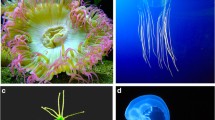Abstract
Sharks and rays are highly sensitive to chemical stimuli in their natural environment but several hypotheses predict that hammerhead sharks, with their expanded head and enlarged olfactory epithelium, have particularly acute olfactory systems. We used the electro-olfactogram (EOG) technique to compare the relative response of the scalloped hammerhead shark (Sphyrna lewini) olfactory epithelium to 20 proteinogenic amino acids and determine the sensitivity for 6 amino acids. At micromolar concentrations, cysteine evoked the greatest EOG response which was approximately twice as large as that of alanine. The weakest response was obtained for proline followed by aspartic acid and isoleucine. The olfactory epithelium showed adaptation to sequential stimulation, and recovery was related to the inter-stimulus time period. Estimated EOG response thresholds were in the sub-nanomolar range for both alanine (9.2 × 10−11 M) and cysteine (8.4 × 10−10 M) and in the micromolar range for proline and serine. These thresholds from 10−10 to 10−6 M for the scalloped hammerhead shark are comparable or lower than those reported for other teleost and elasmobranch species. Future work should focus on binary and more complex compounds to test for competition and cross-adaptation for different classes of peripheral receptors, and their responses to molecules found in biologically relevant stimuli.


Similar content being viewed by others
References
Caprio J (1978) Olfaction and taste in the channel catfish—electrophysiological study of response to amino acids and derivatives. J Comp Physiol A 123:357–371
Caprio J (1982) High sensitivity and specificity of olfactory and gustatory receptors of catfish to amino acids. In: Hara TJ (ed) Chemoreception in fishes. Elsevier, Amsterdam, pp 109–134
Compagno LJV (1984) FAO Species catalogue, Sharks of the world. An annotated and illustrated catalogue of shark species known to date. Part 2, Carcharhiniformes. FAO Fish Synop 4(Pt2):251–655
Compagno LJV (1988) Sharks of the order Carcharhiniformes. Princeton University Press, Princeton, NJ
Duncan KM, Holland KN (2006) Habitat use, growth rates and dispersal patterns of juvenile scalloped hammerhead sharks Sphyrna lewini in a nursery habitat. Mar Ecol Prog Ser 312:211–221
Gilbert CR (1967) A revision of the hammerhead sharks (Family Sphyrnidae). Proc US Nat Mus 119(3539):1–88
Gilbert PW, Hodgson ES, Mathewson FF (1964) Electroencephalograms of sharks. Science 145:949–951
Hara TJ (1992) Mechanisms of olfaction. In: Hara TJ (ed) Fish chemoreception. Chapman & Hall, London, pp 150–170
Hara TJ (1994) The diversity of chemical stimulation in fish olfaction and gustation. Rev Fish Biol Fish 4:1–35
Hara TJ (2005) Olfactory responses to amino acids in rainbow trout: revisited. In: Reutter K, Kapoor BG (eds) Fish chemoreceptors. Science Publishers, Enfield, pp 31–65
Hasler AD (1957) The sense organs: olfaction and gustatory senses of fishes. In: Brown ME (ed) The physiology of fishes, vol 2. Academic Press, New York, pp 187–210
Hodgson ES, Mathewson RF (1978) Electrophysiological studies of chemoreception in elasmobranchs. In: Hodgson ES, Mathewson RF (eds) Sensory biology of sharks, skates and rays. US Government Printing Office, Washington DC, pp 227–267
Johnsen PB, Teeter JH (1985) Behavioral responses of bonnethead sharks (Sphyrna tiburo) to controlled olfactory stimulation. Mar Behav Physiol 11:283–291
Kajiura SM, Forni JB, Summers AP (2005) Olfactory morphology of sphyrnid sharks—does the cephalofoil confer a sensory advantage? J Morph 264:253–263
Kleerekoper H (1978) Chemoreception and its interation with flow and light perception in the locomotion and orientation of some elasmobrachs. In: Hodgson ES, Mathewson RF (eds) Sensory biology of sharks, skates and rays. US Government Printing Office, Washington DC, pp 269–329
Mathewson RF, Hodgson ES (1972) Klinotaxis and rheotaxis in orientation of sharks toward chemical stimuli. Comp Biochem Physiol 42A:70–84
Michel WC (2006) Chemoreception. In: Evans DH, Claiborne JB (eds) The physiology of fishes. CRC Press, Boca Raton, pp 471–497
Nelson DR (1969) The silent savages. Oceans 1:8–22
Nikonov AA, Ilyin YN, Zherelova OM, Fesenko EE (1990) Odour thresholds of the black sea skate (Raja clavata). Electrophysiological study. Comp Biochem Physiol 95A:325–328
Parker GH (1914) The directive influence of the sense of smell in the dogfish. Bull US Bur Fish 33:61–68
Silver WL (1979) Olfactory responses from a marine elasmobranch, the Atlantic stingray, Dasyatis sabina. Mar Behav Physiol 6:296–305
Silver WL, Caprio J, Blackwell JF, Tucker D (1976) The underwater electro-olfactogram: a tool for the study of the sense of smell of marine fishes. Experientia 32:1216–1217
Sorenson PW (1992) Hormones, pheromones and chemoreception. Mechanisms of olfaction. In: Hara TJ (ed) Fish chemoreception. Chapman & Hall, London, pp 199–228
Tester AL (1963) Olfaction, gustation, and the common chemical sense in sharks. In: Gilbert PW (ed) Sharks and survival. DC Heath, Lexington, pp 255–282
Zeiske E, Caprio J, Gruber SH (1986) Morphological and electrophysiological studies on the olfactory organ of the lemon shark, Negaprion brevirostris (Poey). In: Uyeno T, Arai R, Taniuchi T, Matsuura K (eds) Proceedings of the second international conference on Indo-Pacific fishes. Ichthyological Society of Japan, Tokyo, pp 381–391
Zeiske E, Theisen B, Gruber SH (1987) Functional morphology of the olfactory organ of two carcharhinid shark species. Can J Zool 65:2406–2412
Acknowledgments
We thank T. Meredith, A. Rivera, J. Sewell and L. Sharkey for assistance with the experiments; L. Riley for sharing temporary holding tank space; and the anonymous reviewers for their comments on drafts of the manuscript. All collection methods and experimental protocols used in this study were approved by the University of Hawaii IACUC. This work was funded by Defense Advanced Research Program Agency (DARPA) to TCT and the McDowell Foundation to APS. This is contribution number 1353 from the Hawaii Institute of Marine Biology.
Author information
Authors and Affiliations
Corresponding author
Rights and permissions
About this article
Cite this article
Tricas, T.C., Kajiura, S.M. & Summers, A.P. Response of the hammerhead shark olfactory epithelium to amino acid stimuli. J Comp Physiol A 195, 947–954 (2009). https://doi.org/10.1007/s00359-009-0470-3
Received:
Revised:
Accepted:
Published:
Issue Date:
DOI: https://doi.org/10.1007/s00359-009-0470-3




